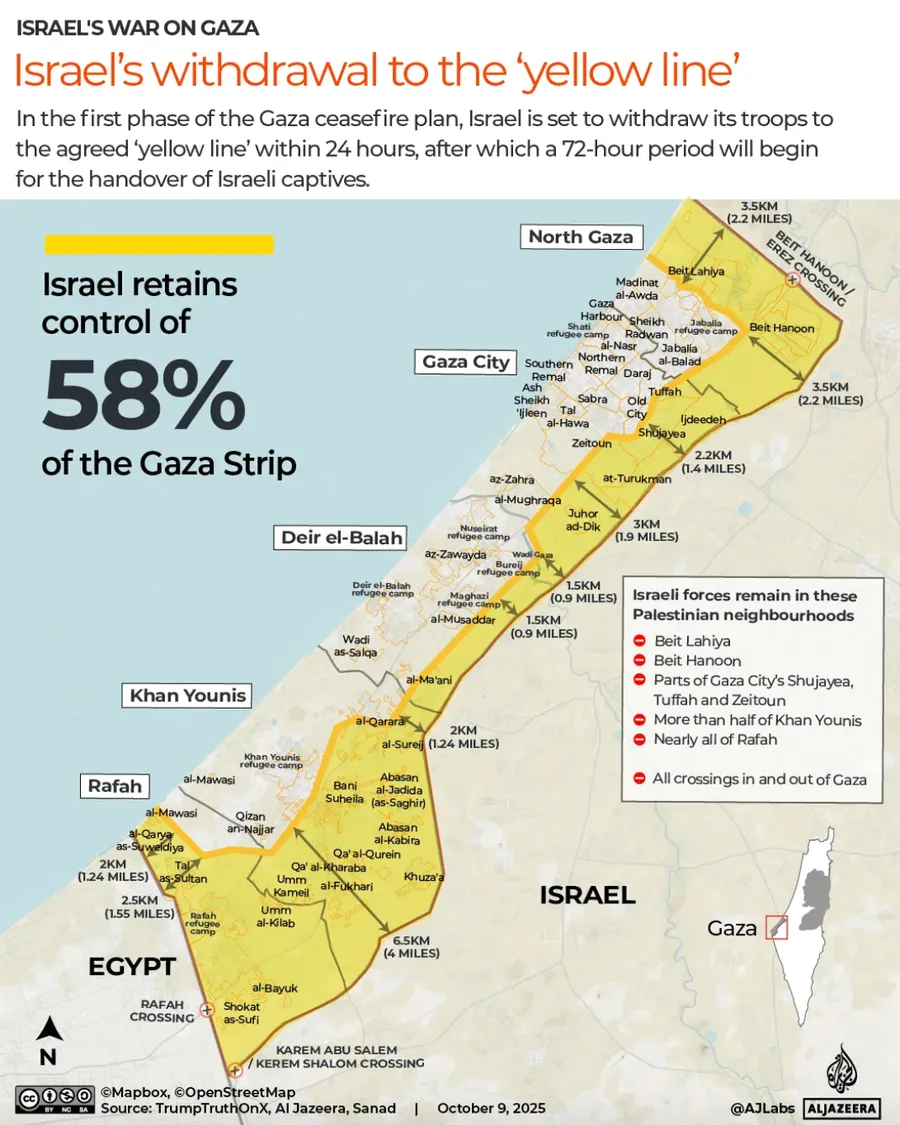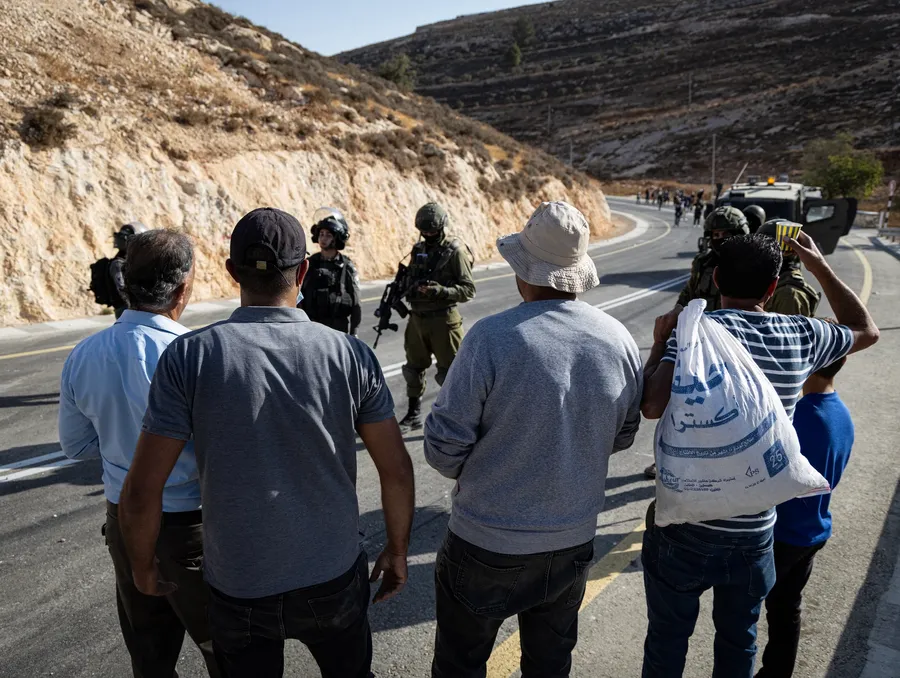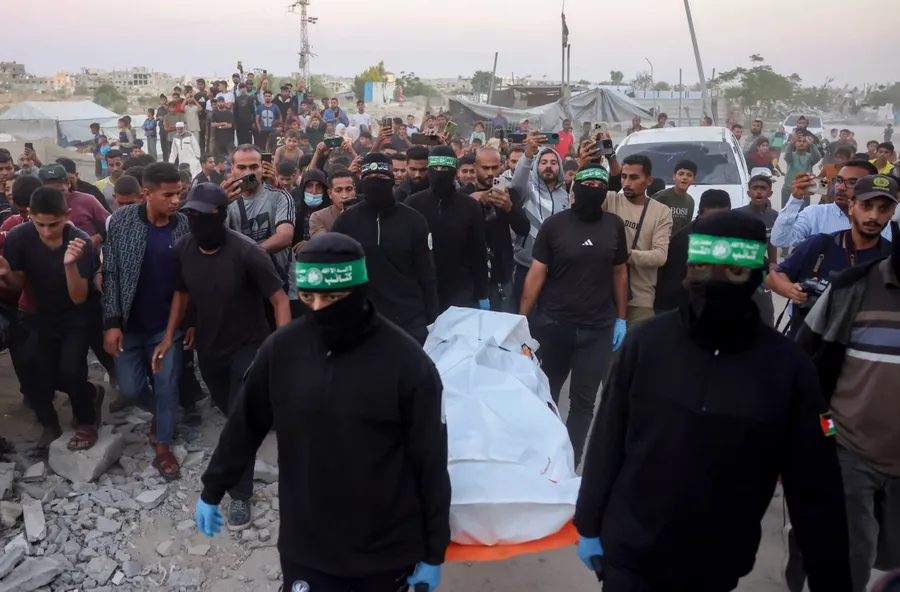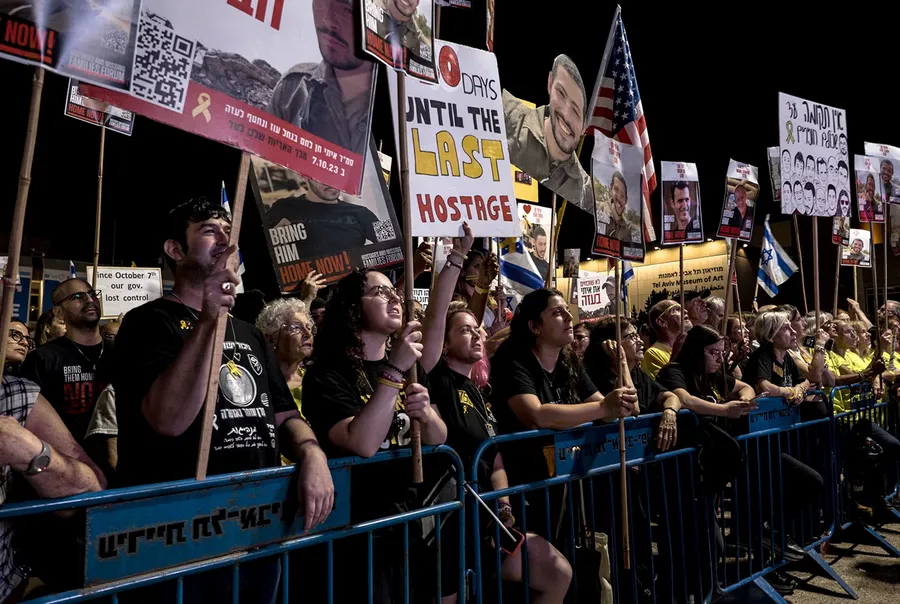Ceasefire and Contiguity: How the Gaza Truce Could Reshape the West Bank
by u/DemosthenesRex
The current peace agreement between Israel and Hamas represents far more than a temporary suspension of violence; it is a moment freighted with strategic ambiguity and political consequence. On its surface, the truce appears pragmatic, an attempt to mitigate humanitarian collapse in Gaza and to create a diplomatic aperture for regional stabilization. Yet beneath that surface lies a rethinking of political power extending beyond Gaza’s borders and into the heart of the West Bank, where Israeli policy has long blurred the distinction between military necessity and territorial ambition. The terms of the truce, particularly those involving humanitarian corridors, phased withdrawals, and international oversight, may subtly redefine Israel’s calculus toward the broader Palestinian territories, shaping whether the state pursues containment, annexation, or a hybrid strategy of indefinite management. For policymakers and analysts alike, the question is not whether the ceasefire will hold, but rather how its architecture will be leveraged to consolidate, or possibly erode, the spatial and political fragmentation that has long defined the Israeli-Palestinian conflict.

This moment also exposes the contradiction inherent in Israel’s dual pursuit of security and territorial permanence. The truce creates temporary quiet, but it also provides the political latitude necessary for Israeli leaders to refocus attention on the West Bank, where settlement expansion and demographic manipulation continue to alter the facts on the ground. If the Gaza ceasefire becomes a prelude to renewed assertion in the West Bank, it risks transforming a humanitarian reprieve into an inflection point of irreversible geopolitical consequence. Conversely, if external actors, particularly the United States and key regional intermediaries, use the pause to reassert conditions for accountability and restraint, the ceasefire could paradoxically reopen the moribund debate over sovereignty and statehood. Thus, what appears as an armistice in one arena may prove to be the preface to a broader reconfiguration of the territorial and moral landscape of the conflict itself.
The recently brokered ceasefire between Israel and Hamas, while publicly framed as a humanitarian pause, represents a highly calculated modification of military and political leverage rather than a genuine cessation of hostilities. Its terms, structured around hostage exchanges, aid deliveries, and conditional extensions tied to Hamas’ compliance, reflect an uneasy truce mediated under immense international scrutiny. For Israel, the agreement functions as a strategic interlude, providing time to consolidate battlefield gains and reassess force deployment without the reputational costs of sustained bombardment. For Hamas, it serves as a reprieve from existential exhaustion, an opportunity to regroup politically amid the ruins of Gaza, and a test of its capacity to translate survival into legitimacy. Yet, the ceasefire’s fragility underscores the broader contradiction of the conflict: a temporary pause that stabilizes violence in Gaza only to shift its gravitational center toward the West Bank, where settler expansion and reciprocal attacks continue unchecked.
This displacement of kinetic focus from Gaza to the West Bank reveals how the logic of security in the Israeli-Palestinian conflict has metastasized across geography rather than being resolved. The truce, by creating a semblance of calm, allows both the Israeli government and the United States to reorient diplomatic narratives toward reconstruction and “stability,” while local dynamics trend in the opposite direction. Settler violence, military raids, and creeping annexation accelerate under the cover of diplomatic fatigue, eroding the moral coherence of ceasefire diplomacy itself. In effect, the truce operates less as a peace mechanism than as a pressure valve, relieving international outrage while preserving the structural asymmetries that sustain the conflict. The temporary stillness in Gaza, therefore, conceals a deeper turbulence: a reconfiguration of territorial control and political ambition that may yet prove more consequential than the war it ostensibly suspends.
Israel’s truce with Hamas, while temporarily muting the intensity of Israel’s southern front, has created new strategic bandwidth for the Israeli government to consolidate its control over the West Bank. In the absence of large-scale operations in Gaza, the West Bank once again becomes the principal arena through which Israel can operationalize its long-term territorial vision. Settler movements, already emboldened by years of permissive governance, have accelerated land seizures and outpost construction under the pretext of “security coordination” and retaliation. This expansionary drive is not simply the product of ideological zeal but of a calculated state policy that fuses civilian encroachment with military protection. In effect, Israel’s West Bank policy functions as a low-intensity occupation sustained through bureaucratic normalization; issuing permits, redrawing zoning maps, and retroactively legalizing unauthorized settlements under the legal fiction of administrative necessity.
Simultaneously, the Israel Defense Forces have deepened their operational entrenchment in the West Bank, maintaining an infrastructure of control that blurs the line between military security and political governance. The proliferation of checkpoints, raids, and selective closures has rendered mobility a contingent privilege, effectively transforming the geography of the West Bank into a fragmented matrix of control. Each new security installation doubles as both a tactical instrument and a cartographic statement, inscribing the permanence of occupation into the landscape itself. The ceasefire’s political logic thus surprisingly enables escalation elsewhere. While Israel publicly markets restraint in Gaza, it deploys intensified coercion in the West Bank to preempt any semblance of Palestinian political resurgence. This inversion, pacification on one front, entrenchment on another, reveals the strategic continuity underlying Israel’s territorial management.

The Israeli army prevents Palestinians from reaching their lands to harvest olives after declaring the area a closed military zone on October 23, 2025, in Si'ir, Hebron. (Faiz Abu Rmeleh / Getty Images)
At the level of political discourse, these maneuvers are underwritten by a shifting rhetoric that conflates security imperatives with sovereignty claims. Key figures within the governing coalition frame settlement expansion as the natural corollary of defensible borders, thereby eroding the distinction between temporary occupation and de jure annexation. International objections have little restraining effect, as the Israeli leadership recognizes that episodic condemnations rarely translate into material consequences. The result is a form of strategic incrementalism, a policy of accretion rather than rupture, in which the accumulation of small, legally ambiguous actions achieves what formal annexation cannot. If the Gaza ceasefire was intended at least in part, to stabilize the conflict’s periphery, it has instead served as a political accelerant for Israel’s deeper entrenchment in the West Bank, signaling that the state’s long-term security doctrine remains inseparable from its territorial ambitions.
Though fraught with many hurdles, the lull in fighting has lead to an opening for the Palestinian Authority to reassert a semblance of political relevance in the West Bank. For years, the PA’s legitimacy has eroded under the weight of corruption allegations, authoritarian governance, and its perceived complicity with Israel’s occupation through security coordination. Now, as the guns temporarily fall silent in Gaza, the vacuum in Palestinian national leadership has grown more visible than ever. International actors, including the United States and the European Union, appear increasingly intent on positioning the PA as a potential administrative partner for Gaza’s reconstruction and governance, an initiative that risks overestimating its capacity while underestimating the depth of Palestinian disenchantment. The challenge lies not only in reviving the PA’s political standing but in reconstituting it as a credible representative of a fragmented and traumatized polity.
Yet the calculus for re-legitimization is neither linear nor internally coherent. A durable truce that stabilizes Gaza could also theoretically undermine the PA’s claim to leadership by demonstrating Hamas’s ability to extract concessions through resistance rather than diplomacy. At the same time, failure to translate the ceasefire into tangible gains for Palestinians in the West Bank, such as reduced settler incursions or eased movement restrictions, could further expose the PA’s impotence. Within Ramallah’s political apparatus, the tension between administrative continuity and revolutionary authenticity has become existential. The PA governs, but it does not lead; it survives, but it does not inspire. As regional and Western diplomats explore frameworks for revitalizing the Authority, they risk mistaking institutional endurance for legitimacy, a conflation that has historically perpetuated, rather than resolved, Palestinian political stagnation.
Reconstituting Palestinian legitimacy in the West Bank thus requires more than bureaucratic rehabilitation. It necessitates a moral and political reworking of what representation means under occupation. The PA’s security coordination with Israel, long justified as a pragmatic mechanism to prevent chaos, has become an emblem of subservience in the Palestinian public consciousness. Without recalibrating its role from an enforcer of order to an advocate of sovereignty, the PA’s credibility will continue to erode, regardless of international support. Any sustainable governance framework emerging from the Gaza ceasefire must therefore integrate mechanisms of accountability, inclusivity, and territorial coherence that transcend factional survival. If the ceasefire is to catalyze political renewal rather than entrench division, the PA must evolve from a vestige of Oslo into a genuine instrument of national representation, a transformation that will test not only its institutional will but the international community’s capacity for imaginative diplomacy.
The armistice's endurance will hinge not only on Israel’s strategic calculus but on the evolving equilibrium within Palestinian politics, where legitimacy has become a scarce and contested resource. Hamas’s ability to survive an intensive Israeli campaign and still negotiate a truce, however tenuous, reinforces its image among many Palestinians as the only actor capable of extracting concessions through force. This perceived endurance stands in contrast to the Palestinian Authority’s stagnation and deepening crisis of credibility in the West Bank. For decades, Fatah’s leadership has positioned itself as the indispensable partner for diplomacy and statehood, yet its detachment from on-the-ground realities, especially amid expanding settlements and settler violence, has hollowed out that claim. The truce, ironically, could consolidate Hamas’s symbolic capital even as Gaza lies in ruin, recasting the political hierarchy within Palestinian society and forcing external powers to reckon with a movement they had sought to isolate.

Hamas members carry a body retrieved from a tunnel in an area north of Khan Younis, in the southern Gaza Strip, on Tuesday. Israel accused Hamas of staging its search for the remains of a Gaza hostage body. (Bashar Taleb/AFP via Getty Images)
Yet this outcome is not inevitable. A ceasefire that reintroduces international aid mechanisms or demands civilian governance may open space for the Palestinian Authority to reassert administrative control, particularly if external actors, including the United States and Egypt, condition reconstruction funds on its participation. The PA’s potential resurgence, however, would depend on a radical reconfiguration of its internal structure. Credible elections, anti-corruption reforms, and tangible achievements that resonate with a population weary of paralysis. Meanwhile, Hamas’s rivals within the Palestinian political spectrum, smaller Islamist and leftist factions, could exploit the truce to redefine resistance politics outside the binary of armed struggle and diplomatic stagnation. In this fragmented field, the question of who speaks for Palestinians in future negotiations over the West Bank is no longer procedural but existential, shaping the legitimacy of any prospective peace architecture.
The viability of any final-status agreement concerning the West Bank increasingly hinges on the preservation, or erosion, of territorial contiguity. Israel’s continued settlement expansion and the steady proliferation of settler-only infrastructure have transformed the geography of the West Bank into a fractured mosaic of enclaves, outposts, and segregated roads. What was once conceived as a contiguous Palestinian territory has been methodically subdivided by spatial mechanisms of control, undermining both the administrative coherence and economic viability of a future Palestinian state. Settler violence, operating with varying degrees of impunity and often under the passive sanction of the Israeli security apparatus, further accelerates this process of disintegration. Such violence is not merely spontaneous or reactionary; it functions as a parallel strategy of deterrence and displacement, designed to constrict Palestinian mobility and consolidate de facto annexation under the guise of local disorder. The resulting territorial entropy renders traditional peace frameworks, premised on reciprocal borders and land-for-peace formulas, functionally obsolete.
Beyond its immediate humanitarian cost, this systematic erosion of contiguity carries profound political and diplomatic implications. Each new outpost or confiscated tract of land constrains the geographic imagination of negotiators and narrows the conceptual space for compromise. The entrenchment of settlers as a politically potent constituency within Israel makes reversal politically improbable, even were an agreement reached in principle. Thus, the West Bank’s fragmentation operates simultaneously as a physical and political fact, locking both societies into an asymmetrical stalemate. For the international community, the dilemma is acute. Continued financial and diplomatic investment in a two-state paradigm risks legitimizing a process that has already hollowed out the territorial basis of statehood. Without mechanisms capable of halting or reversing settlement expansion, through binding international guarantees or domestic political transformation within Israel, the notion of a viable Palestinian state may persist only as rhetorical fiction, detached from the realities inscribed upon the land itself.
Efforts to impose meaningful constraints on Israeli settlement expansion in the West Bank have repeatedly collided with the inherent disparities of international law and domestic political sovereignty. Although successive U.N. resolutions have condemned settlement activity as a violation of the Fourth Geneva Convention, enforcement has been largely symbolic, limited to diplomatic censure and episodic funding conditionality. Israel’s deep integration into Western security architectures, particularly its defense and intelligence partnerships with the United States and Europe, has insulated it from punitive measures that might carry tangible consequences. The result is a form of juridical paralysis. International institutions can articulate norms but cannot compel compliance. In this vacuum, “facts on the ground” have become the operative instrument of territorial redefinition, allowing Israel to consolidate strategic depth while external actors debate procedural remedies.
The central challenge in enforcing border integrity and restraining settler violence is not the absence of legal mechanisms but the absence of political will. Proposals for international monitoring missions, whether through U.N. observers, EU task forces, or hybrid Israeli-Palestinian oversight bodies, have historically failed because they depend on the host state’s consent and are constrained by mandates that preclude coercive enforcement. Even U.S. leverage, theoretically the most potent given its financial and military aid portfolio, has been selectively applied and frequently subordinated to domestic political calculus. Washington’s reliance on persuasion over pressure has allowed Israel to treat settlement policy as an internal security matter rather than a subject of international obligation. In practice, this has transformed external oversight into a rhetorical device, a way of managing optics rather than altering behavior.
To reverse this dynamic, any post-conflict framework seeking to stabilize the West Bank must establish mechanisms that bind rather than merely advise. This could entail a reconfiguration of U.S. aid structures to include explicit benchmarks tied to settlement freezes, or the creation of a multilateral verification body endowed with the authority to report violations directly to the Security Council. Yet even such innovations would face resistance from an Israeli government that perceives external monitoring as an infringement on sovereignty and from international actors reluctant to provoke a diplomatic rupture. The dilemma, therefore, is conceptual as much as procedural. Constraining settlement activity requires redefining sovereignty not as absolute autonomy but as reciprocal accountability within a rules-based system. Without that, the prospect of enforceable borders, and by extension, a viable peace, remains an abstraction sustained more by diplomatic ritual than by political reality.
The fragile ceasefire between Israel and Hamas has generated an uncertain interlude, an interval less of peace than of revision. What follows will determine whether this truce functions as a bridge toward diplomatic reconstruction or as a pause preceding deeper fragmentation. In the West Bank, the strategic equilibrium that emerges will likely hinge on whether international actors can translate rhetorical commitments into enforceable mechanisms. Without tangible limits on settlement expansion and a credible effort to restore the Palestinian Authority’s legitimacy, the ceasefire risks solidifying rather than alleviating the inequities that have long defined the conflict. The apparent de-escalation in Gaza may paradoxically accelerate Israel’s territorial consolidation elsewhere, producing a reality that renders the notion of Palestinian contiguity increasingly illusory. What is at stake, therefore, is not merely the endurance of the truce but the architecture of any future political geography in which both peoples might coexist.

Israelis gather at Hostages Square in Tel Aviv to demand the return of the hostage bodies still held in Gaza on Sunday, October 26. (Mostafa Alkharouf/Anadolu/Getty Images)
The coming months will reveal whether international diplomacy can confront, rather than accommodate, the structural conditions that perpetuate conflict. For all the language of reconstruction and restraint, the underlying logic of control remains largely unaltered, anchored in a security paradigm that privileges domination over coexistence. If global and regional actors fail to impose meaningful accountability for settler violence and annexationist policies, the ceasefire will stand as little more than a prelude to renewed displacement and disillusionment. Conversely, a concerted international effort that couples aid with legal oversight and political conditionality could transform this moment. The question, ultimately, is whether the present truce will inaugurate the slow work of political symmetry, or simply entrench, under the guise of stability, a new and more permanent form of fragmentation.